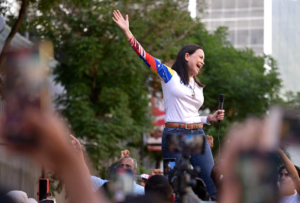How Gestures Shape Public Perception
In the realm of politics, words are undeniably powerful, but body language and gestures play an equally significant role in shaping public perception. One such striking example is the communication style of former U.S. President Donald Trump. His signature hand gestures, particularly his frequent use of pointing, have become a hallmark of his public appearances, strengthening his connection with supporters and reinforcing his political messages.

The Science Behind Trump’s Gestures
Christopher Hart, a professor of linguistics at Lancaster University in the U.K., has extensively studied how politicians use nonverbal communication to engage and influence audiences. In a study published in Social Semiotics, Hart analyzed Trump’s gestures during campaign rallies and discovered that he used a pointing gesture more than once per minute—a significantly high frequency compared to other politicians.
Trump’s pointing gestures serve multiple strategic purposes:
- Engaging His Supporters – When pointing directly at audience members, Trump creates a sense of personal connection, making his followers feel seen and acknowledged. This fosters loyalty and emotional investment in his message.
- Singling Out Opponents – When he points at critics, political rivals, or the media, he effectively “others” them, positioning them as adversaries and rallying his base against them.
- Reinforcing His Brand – Trump frequently points to himself or to his branded merchandise (such as the iconic “Make America Great Again” hats), reinforcing his identity as both a leader and a cultural figure.
- Theatrical Performance – His exaggerated pointing mimics gestures commonly seen in entertainment industries, particularly in professional wrestling, where he has had past affiliations with WWE. This dramatization adds to the spectacle of his rallies, keeping audiences engaged.
The Psychological Impact of Gestures in Politics

Nonverbal cues, such as pointing, serve as subconscious signals that can influence public perception. Studies suggest that strong, deliberate gestures enhance a leader’s perceived confidence and authority. By frequently pointing, Trump asserts dominance over the space, signaling control and assertiveness to his audience.
Unlike traditional politicians who are advised to use minimal, controlled gestures to convey professionalism (such as the well-known “thist” hand position—placing a thumb over a closed fist, used by Barack Obama and other leaders), Trump’s freewheeling, spontaneous style gives the impression of authenticity. This deviation from conventional political body language strengthens his image as a populist leader who “tells it like it is.”
Why It Matters: The Broader Implications

Understanding the impact of nonverbal communication is crucial in analyzing modern political discourse. Trump’s gestural style exemplifies a broader trend in political engagement—where emotions, spectacle, and relatability often outweigh policy discussions. His success in using body language to captivate audiences demonstrates the power of nonverbal communication in building a dedicated political following.
For politicians, activists, and communicators, mastering nonverbal cues is an invaluable skill. In an era where digital media amplifies every public appearance, the ability to connect with audiences through both words and gestures can be a defining factor in influence and leadership.
Final Thoughts
Trump’s frequent use of pointing is not just a habitual gesture but a calculated communication strategy that resonates deeply with his base. Whether used to foster connection, single out opponents, or reinforce his brand, his nonverbal cues play a pivotal role in his political appeal.
As political landscapes continue to evolve, nonverbal communication will remain a key tool for leaders looking to engage and persuade audiences. Observing and understanding these nuances can offer valuable insights into the mechanics of political influence and public engagement.




